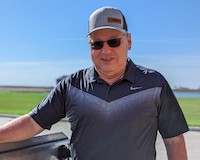
Back in the 1980s, when I started in equipment sales in Ontario, Canada it was a tough time for farmers because interest rates were 23% as compared to today’s rates at 7-9%. It was a different world than the low rates we just experienced. Farmers struggled to stay ahead of interest costs alone.
I started working for a grain and feed handling equipment distributor in Ontario. Sales were tough and on a must-needed basis during those first years. One big difference from that time to now is that Ontario corn yields were hovering around 100 bushels per acre and now farmers there are pushing north of 200, due to plant technology as well as equipment technology.
I then joined a global shortline company, Kongskilde, based out of Ontario for 10 years before being transferred to Europe. While based in Denmark, cereal crops were the majority of what was grown versus corn and soybeans in North America.
They were using tram lines for controlled traffic farming systems then for the sprayers and all equipment. It was built on permanent wheel tracks where the crop zone and traffic lanes are permanently separated to improve profitability and sustainability.
In the early 2000s, when I returned to the U.S. from Denmark, autosteer was just starting. The game changer for farmers was gaining popularity for tractors and combines.
Another game changer for farm equipment in the last 50 years is ergonomics on ag equipment. For example, as a boy in Ontario, cabs on tractors -- if they existed -- were basically a weather shelter. Today, they are a farmer’s office complete with computer technology, soundproofing and suspension cabs for a smoother ride so you don’t spill your coffee.
Part of my role was overseeing the development of new tillage equipment capable of handling higher yields which produces more crop residue. This included launching vertical tillage and cultivator programs. During this time I met Mike Lessiter who helped us promote these new products via Farm Equipment. As a result, we were able to grow our dealer network for these products.
Today I still use Farm Equipment to stay up to date on new technology along with mergers and acquisitions in the industry.
Another big change in the last 50 years is the consolidation of equipment dealers. Five decades ago, the majority of dealerships were single-store locations compared to today when some dealer groups are approaching 100 locations, with several having 10 to 30 locations. This has changed how shortline manufacturers approach the marketplace. For a dealer group to engage with a shortline, we must be easy to deal with, show a strong ROI, and have innovative equipment.
Check out other "A Look Back in Farm Equipment History" blogs
Industry commentary on “55 Years of Farm Equipment”
- The ‘5 Greatest Tech Advancements’ in My Career as a Dealer | Leo Johnson, Johnson Tractor
- The Impact of Consolidation & Technology on Agriculture Over Half a Century | Sam Christianson, Titan Machinery
- A Service Manager’s View on the Changing Times | Brent Bazin, Young's Equipment Inc.
- Reflections on Farm Equipment | George Russell, Machinery Advisors Consortium
- Farm Equipment Sales in the 1970s | Charlie Glass, FEMA Dealer Relations Commitee
- Digital Communications Changed the Course of OEMs Working With Dealers | Tom Taylor, retired farm equipment executive
- RDO Equipment’s Take on the Last 55 Years | Daryl Shelton, RDO Equipment
- Reflections from a North American, International & Company-Store Dealer Exec | Stacy Anthony, AgRevolution LLC
- A Lot of Change in Shortline Equipment | Hans Rasmussen, Summers Manufacturing
- Business Acumen, Technology Forever Changed Equipment Sales & Service | Brian R. Carpenter, Champlain Valley Equipment
- Not Your Grandfather’s Farm Equipment Dealership… | Josh Waggener, Hutson Inc
- Left Major OEM Career 55 Years Ago to Become Dealer-Principal | Paul Wallem, Retired International Harvester executive
- Titan Machinery Reflects on Significant Changes to Dealership Environment in 55 Years | David J. Meyer, Titan Machinery
- From 3 Stores Within 50 Miles to 25 Stores Across 8 States | Tom Rosztoczy, Stotz Equipment
- 45 Years of Observations on Ag Equipment Manufacturing & Distribution | Chuck Bellew, retired farm equipment executive
- Today’s Staff Has No Fear Approach to Risk, But It Still Exists | Jeff Morgan, H&R Agri-Power
- A Recent Retiree’s Perspective on Equipment Industry | Lars Paulsson, Laforge Systems
- 60 Years of Equipment Dealer Associations Consolidation Continues | Kim Rominger, NAEDA
- Vast Technology Changes Assisted Dealers’ Computerization | Ed Archambo, Basic Software Systems
- ‘I Didn’t Listen to My Uncle Roy’ | Jon Eis, Eis Implement Co.
- Farm Equipment Manufacturers and the Early 1980s Farm Crisis
- GMO, Autosteer Forever Changed Our Business | Tom Janson, Janson Equipment
- My 35 Years at RME, from Microfiche to Guidance | Jim Wood, Rocky Mountain Equipment
- Export Opportunities Changed Game for Canadian Shortline Manufacturer | Hal Carnago, Schulte Industries Ltd.
- 40 Years with Sunco, Hiniker, Ingersoll, Southern Marketing & Forges de Niaux | Larry Hansen, Forges de Niaux
- From Dreaming Farm Boy to Equipment Dealer | Tim Brannon, B&G Equipment
- Inaugural Cover Story Dealer, 20 Years Later | Ted Mallard, American Equipment Service Inc.
- Farm Equipment Tips the Hat to the Behind-the-Scenes Contribution of An Industry Exec | Patricia Collins, Equipment Manufacturers Distribution Association






